Search the Land Registry in Spain
We help our clients to obtain Spanish Land Registry property search reports (Nota Simple) with detailed translation in English language
You can order your Land Register extract by entering the property details
What is included
The Land Registry Extract is a document issued by a Spanish local Land Registrar and it contains the most updated information about a property in Spain. It's named Nota Simple in Spanish and it can change from day to another, and if there are pending documents being processed, the Land Registry will show this in a special section.
We deliver the extract with accurate English translation, including also the original document and Cadastre extract
This document is issued when the property is found in its local Land Registry after conducting a search by owner name, registry data, address or other data. It can be delivered physically at the local Land Registry's offices or electronically via the Public Law Corporation of Land and Mercantile Registrars of Spain. Check out our guide of land registry extract contents
Here's a sample English translation of a Land Registry Extract
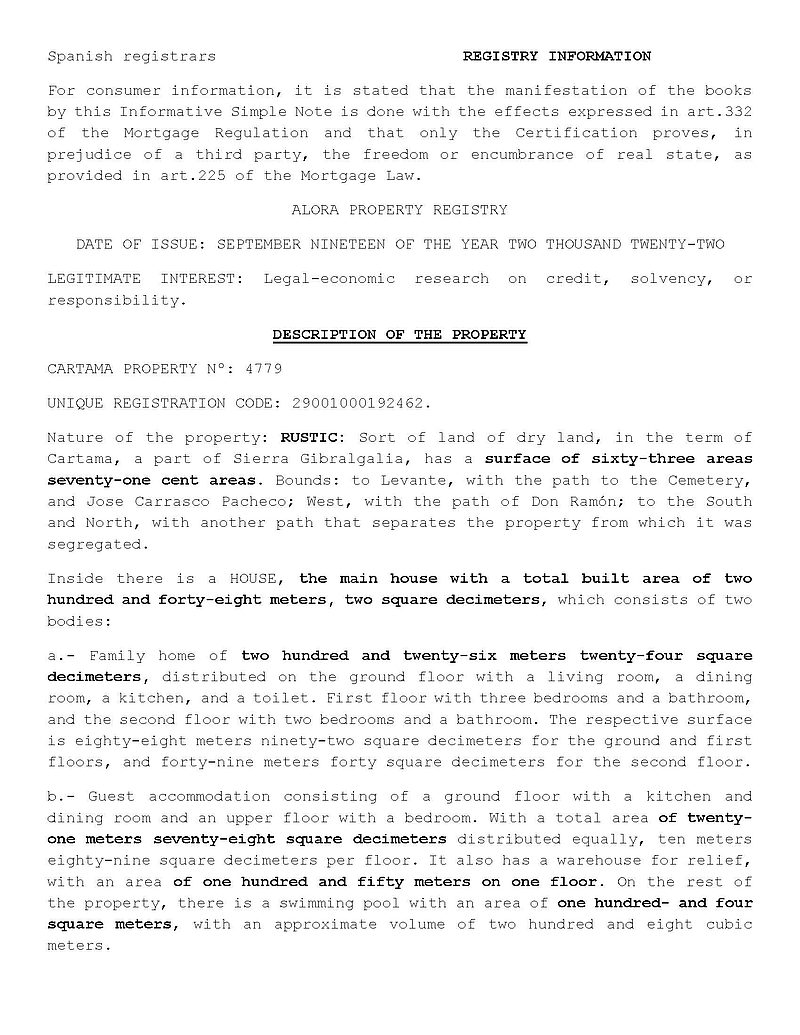
And the original Spanish version
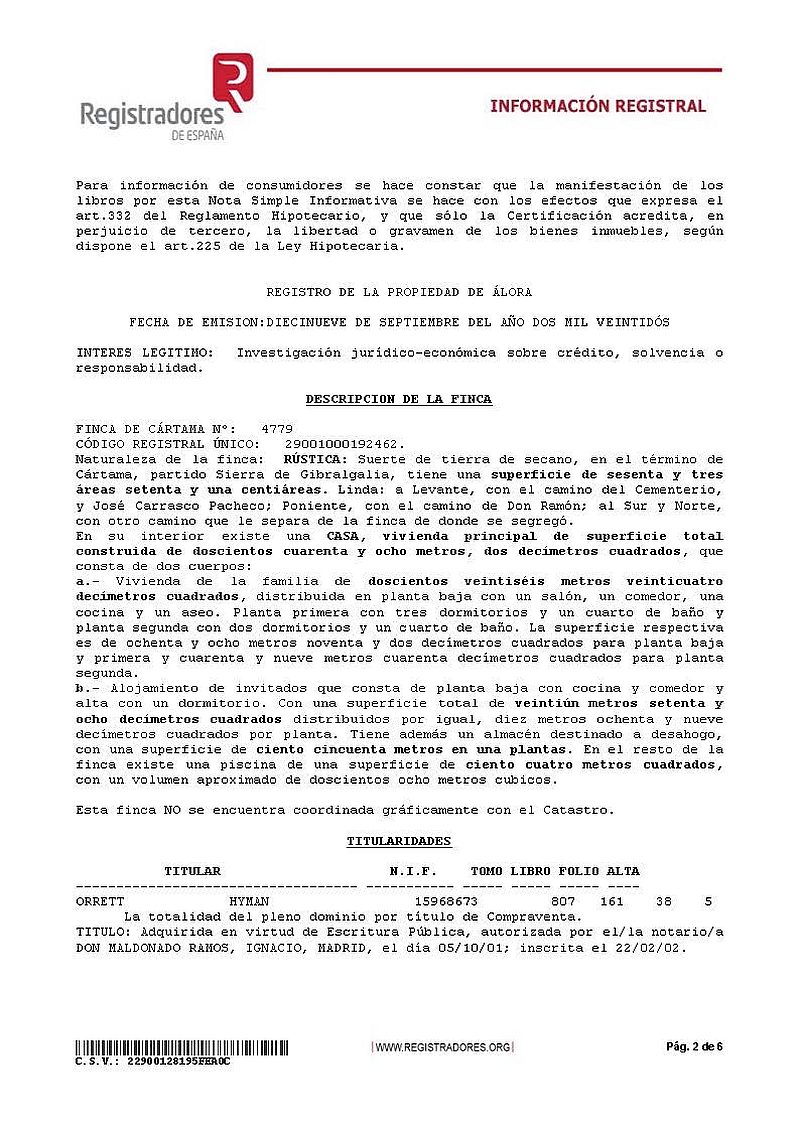
Here's another Land Registry Extract with English translation

Is there a Land Registry in Spain?
Yes, there is a Land Registry in Spain. However, it's important to note that the Land Registry is not a central government body but a group of local registries. Properties are registered in their local Land Registry and only a limited set of information is kept centralized. The central Index Registry (Registro de Índices) kepts information of property owners related to local registries but only binary (yes/no) queries are allowed.
What is the Spanish Land Registry called?
The Spanish Land Registry is called Registro de la Propiedad. The governing body is called Public Law Corporation of Land and Mercantile Registrars of Spain (Colegio de Registradores). There are 1,059 local land registries distributed among the 50 Spanish provinces and 2 autonomous cities.
What is a Nota Simple in Spain?
A Nota Simple is the Spanish name of a non-certified land registry excerpt
Here's a sample Nota Simple in printed version. This is obtained at the counter of the Land Registry office
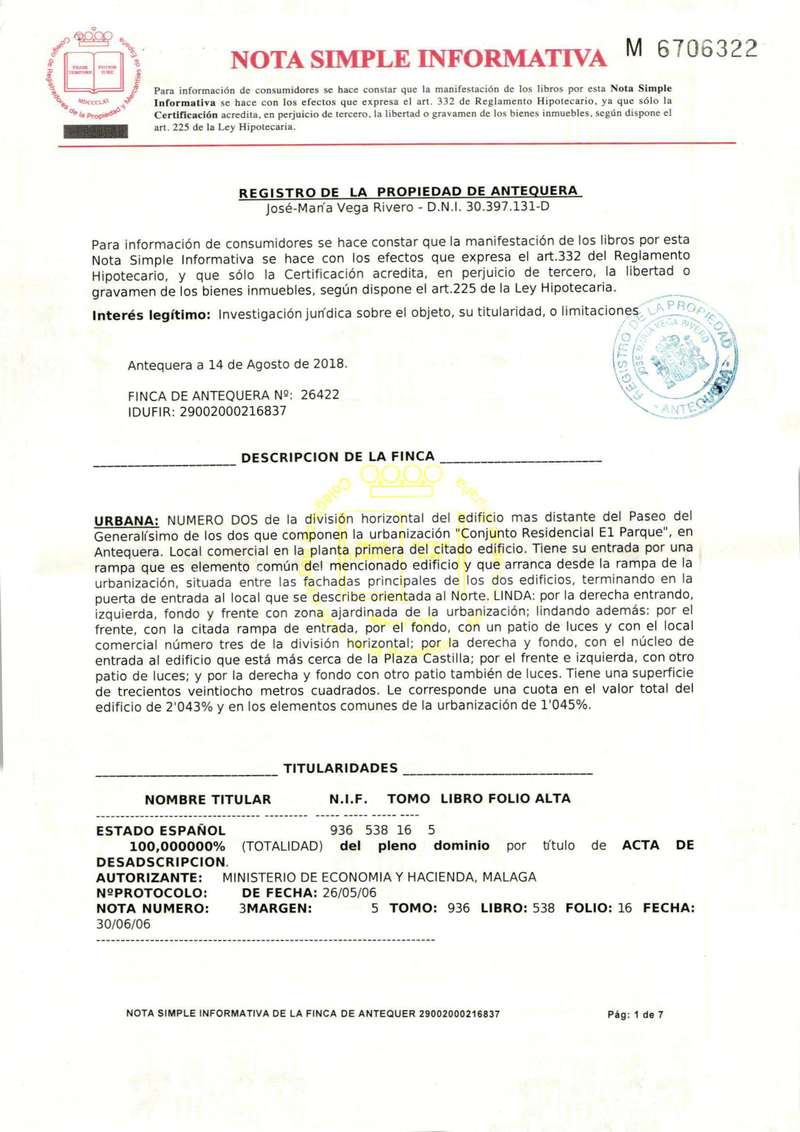
How do I check Land Registry in Spain?
In order to check the Land Registry in Spain, you need to conduct a property search and obtain an extract. Search requires having basic details about the property and its location:
Which Land Registry?
First of all it's very important to determine in which local Land Registry is the property registered. This is related to the property address. In case of small towns, chances are that it's registered in the closest bigger town as small towns don't have their own Land Registry. On the other hand, in case of a big city such as Madrid, Barcelona, Valencia, Seville, Málaga, Alicante, Las Palmas or Palma de Mallorca, depending on the street and neighbourhood it may be registered in one of the multiple Land Registries available. For example, Alicante has 8 land registries, Málaga has 15, Valencia 18, and Barcelona, 30.
This is also disclosed in the house deeds, you have to look the phrase Inscrito en el Registro de la Propiedad, next to this the town name should appear, along with the title register data
But don't worry as we take care of this search for you
Locating the property within the Registry
Once we know which Land Registry we have to search, next step is to locate the property in the Registry. There are several ways to do this:
1. Search by Register data and Title number
The quickest way for locating a property is using the title register data, which is usually the property number (número de finca) and/or the registration information, volume, book, sheet and section (tomo, libro, folio y sección). Optional fields are subsection and entry (subsección, alta y entrada). These fields identify the property in the system. In most cases it's enough to know either of two: property number or registration information. Some special properties may be located only by registration information as the property number may have been changed or subdivided.
Most properties in Spain are identified using these fields along with the CRU code. Newer properties may have the CRU code only
Register data is similar to title register data in the HM Land Registry of the UK. The property number along with the Land Registry name is similar to the Title number.
You can find these details in your property deeds. These are the documents handed to you by the Notary Public when you purchased the property.
What are house deeds called in Spain?
House deeds and title deeds are called escrituras de propiedad in Spanish. There are various types of deeds depending on how the house was acquired. The most common case is a purchase, in which the document is a deed of sale (escritura de compraventa). If the house was inherited, the document is an inheritance title deed (escritura de herencia). In case of self building, the document is a newly-built title deed (escritura de obra nueva). Another possible case is buying a house at auction, in which the document is a court judgement (auto de adjudicación).
Here's a sample of the first page of the most common Spanish house deeds
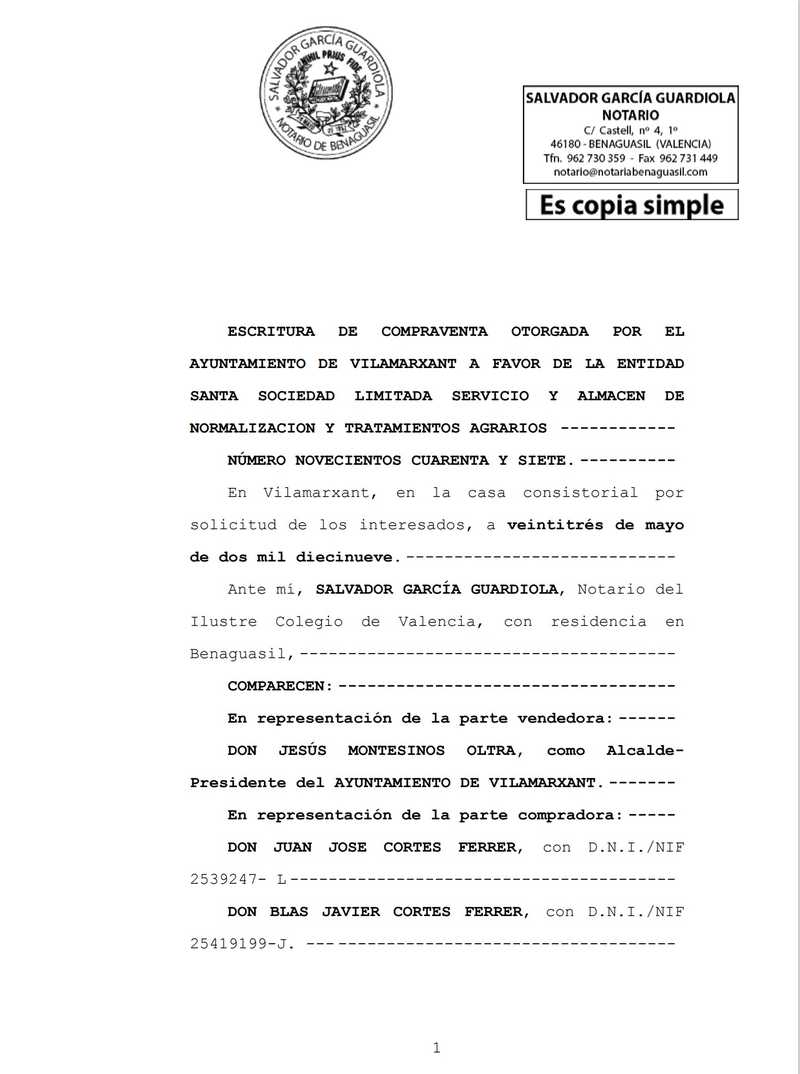
How do I get a copy of my deeds in Spain?
The deeds are kept by the Notary Public where the transaction was signed. You can request a copy of them at any time. Even if the deeds were signed a long time ago and Notary is no longer operating, the deeds are transferred to a new Notary. It's a highly regulated system.
There are two types of copies: plain copy (copia simple) and certified copy (copia autorizada). There are fees for both documents, usually a small fee for plain copies and higher one for certified ones. In most cases a plain copy is enough.
If you don't know in which Notary Public were the deeds signed, you can apply for a Land Registry extract and this information is shown in the Ownership section (Titularidades).
How do I find my Land Registry title number?
The property number and title register data is usually shown next to the property description, and they are identified by the words INSCRIPCION or DATOS DE INSCRIPCION
Here are two samples of title register data within house deeds in Spain
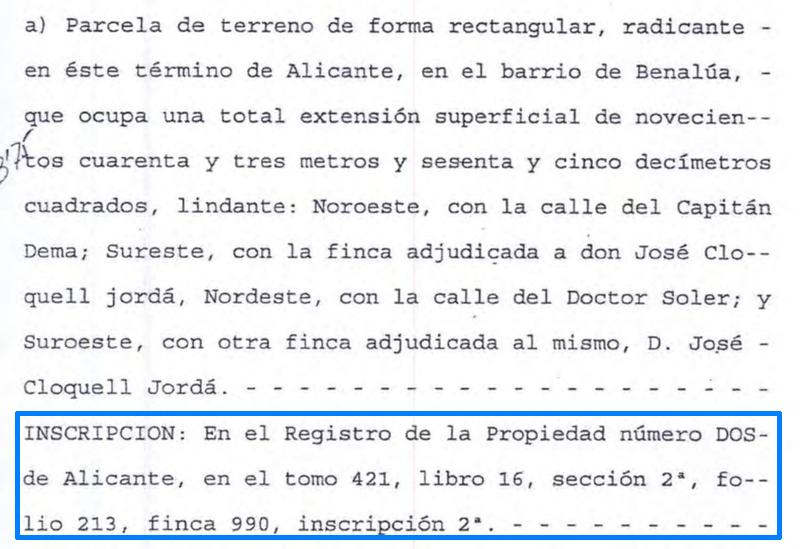

2. Search by owner's name
The second most convenient method to search for a property in a local Land Registry is using the owner's name, starting with the last name. This search includes previous owners and also legal entities.
Downside of this search method is the case when the owner has more than one property registered in that particular Land Registry. In this case, the officers see a list of property numbers with limited description of each property so it's very hard to choose which one is correct. This situation depends on the willingness to help from the officer. Of course it's possible to enter in each property details but this would incur in additional fees
3. Search by property address
As a group, the Public Law Corporation of Land and Mercantile Registrars of Spain is developing new advanced software tools to enable each local Land Registry to search for properties using addresses, coordinates and additional data. Also, some local Land Registries have their own developments tailored to their needs.
However, there are many properties in Spain that don't have geographical coordinates or boundaries registered in the Land Registry. Since the Law 13 of 2015, it's possible to register a graphical representation of the property in the Land Registry. In addition to this, over the years many streets changed their name, and also many properties have changed their street number, due to new developments or division of existing properties. In some cases the street name may be different in the Land Registry than in the Cadastre or the City Council. This makes very complicated for registry officers to search for properties using the address only.
That said, in many cases it's possible to conduct a property search using the address only. This works better in medium to large cities with consolidated neighbourhoods. Please include additional details such as alternative street names and any additional references.
4. Search by Cadastral number/reference
What is the Cadastre in Spain?
The Cadastre is a property register for tax purposes. It depends on the Spanish Tax Authority
Here's an example of a Cadastre extract in Spain:
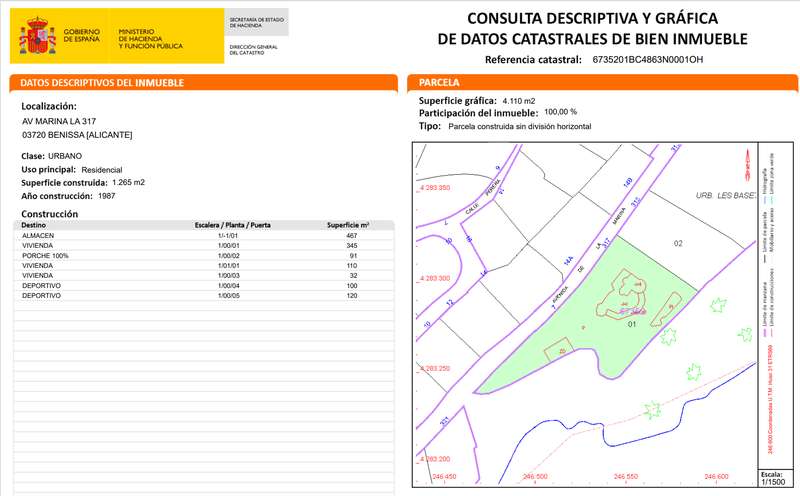
The Cadastral Reference (Referencia catastral) is a 20 character alphanumeric code issued by the Tax Agency to each property in Spain. The Tax Agency (Agencia Tributaria) depends on the Treasury (Ministerio de Hacienda) and it's a completely different entity from the Land Registry. Cadastral references are related to property tax. Both government bodies work closely but their purposes are different. Since Law 1/2004 of March 5th, new property deeds have to include the cadastral reference. But there are millions of properties that haven't changed their owner over the years so there were no new deeds registered, so it's very common that Land Registry excerpts lacks the cadastral reference.
With many land registry records without it, it's usually not possible to search for a property in the Land Registry using the cadastral reference.
It's usually easy to find houses in the Spanish Cadastre but flats and apartments are hard to locate depending on the development. We include the Cadastral extract for most Land Registry Property Searches at no extra cost.
When the property data is different in Cadastre than in Land Registry, the Land Registry always prevails because of its legal nature.
5. Search by Unique registration code / CRU / IDUFIR
This 14 digit code is unique for each property in Spain and it doesn't change over time. It's the quickest way to locate a property but we list it in 5th place because it's not widely available. The first 2 digits correspond to the province, next 3 digits correspond to the local Land Registry, next 8 digits to the property itself, and the last position is a control digit.
It's regulated by Law 13/2015 of June 24th and its name is an acronym for Código Registral Único in Spanish. Since 2016, every property must have a CRU assigned. It was created in 2008 by the land registrars and named IDUFIR, an acronym for Identificador Único de Finca Registral, that is, unique identifier of registry property. In land extracts between 2008 and 2016 the code is referenced as IDUFIR, and since 2016, CRU
6. Search by Geolocation
It's possible to search for properties nationwide using geographical coordinates. This is part of new state-of-the-art registry system and it's very useful for rural properties and land in general. However, as we said before, there are only a few properties registered with graphical representation so its use isn't very practical yet
Spanish Land Registry extract content guide
These are descriptions of the fields of a Spanish Land Registry extract translated into English. The format, contents and order of sections are different for each local Land Registry
- Local Land Registry Office
- The Land Registry issuing the extract
- Date of Issuance
- The date when the extract was issued. As the document takes several days to be translated, this date is always earlier than the delivery date for extracts translated into English
- Issued at request of
- A description of the internal system used to request the extract. This is usually FLOTI for electronically delivered extracts. It may have other values for extracts requested over the counter at the registry office or extracts requested by government bodies
- Type of extract
- It can be a simple non-certified extract (nota simple) or a Certificate
- Identification of the property
- Properties are identified with a specific local Land Registry (Registro de la Propiedad de) Town name or directly the town name and several additional fields:
- Property number (número de finca / finca nº)
- CRU/IDUFIR
- Cadastral reference (referencia catastral)
- Register data: volume, book, sheet and section
- Description of the property
This is the section where the property is described. Depending on which Registry issued the extract, it can include the property identification data within the section. Content can be highly variable, from a few words to a complete dwelling description including living rooms, bedrooms, bathrooms, kitchens, closets and outdoor elements such as pools, tennis courts, etc... This description can be modified when the house is renovated or extended by signing a deed at a Notary Public and filing it to the Land Registry. If the property has a graphical representation registered, it may be also described here along with a special validation code (CSV) to download the geometry from the Cadastre website
In most property searches, the first word of the description classifies the property into urban or rural property. Generally speaking, urban property refers to a built or buildable lot with access to common utilities such as electricity, water and sewage system, and rural property refers to land in the countryside with strict building restrictions. Urban property search descriptions start with URBANA and rural ones with RUSTICA
If the property is an apartment part of a condominium, the identification must include specific details of building, floor and door number, and the homeowners association share participation.
Social/subsidized housing terms may also be described in this section, if applicable. Usually this are identified by acronyms VPO (vivienda de protección oficial) or VPP (vivienda de protección pública) which stand for official protection dwelling and public protection dwelling, respectively
- Property boundaries (borders)
- For most properties boundaries are described with different levels of detail. Older properties list adjacent properties with their owner's names. This system is obsolete and land registrars tend to include property numbers, cadastral references or cru codes. When geographical representation is available the borders may include their approximate length in meters
- Easements
- Any kinds of easements are described in the description of the property section or next to it
- Ownership
This section lists the owners of the property along with their identification, share percentage in case of joint property ownership, title type and details on how they obtained their title. For married couples, details of the marriage economic terms will be included. Owner name is sometimes shown as "last name first" by some Land Registry offices, and "first name first" by others. There's no establsihed rule for name ordering.
In some extracts this is shown as a table with the following columns:- Owner
- Identification number (NIF or CIF)
- Volume
- Book
- Sheet
- Entry
Property owner identification numbers
Each owner of the property is identified by the full name and identification number. Foreign individual owners are identified by their NIE number. NIE is the acronym in Spanish for Identification Number for Foreigners (número de identidad de extranjero). If the propery is owned by a Spanish individual or a foreign company, it will be identified by its NIF number. NIF is the acronym in Spanish for Tax Identification Number (número de identificación fiscal). In case of a Spanish company, it may be identified by the old CIF number, acronym for Tax Identification Code (código de identificación fiscal) or NIF number.
Title type / Tenure type
Roughly there are three types of property title in Spain:
- Full ownership (pleno dominio). This is the combination of bare title and usufruct and equals to full rights on the property.
- Bare title (nuda propiedad). This is the same as bare property, the legal ownership of the property but not the right to use of the property (usufruct)
- Usufruct (usufructo). This is the right to use the property but not the ownership.
All ownership records in Spanish property searches include the share percentage, which is 100% for sole owners and usually 50% in married couples.
Details on when and how the title was obtained are shown next to the title type. In most cases this is a date next to the Notary public name and the city where the purchase deed was signed. There are other situations such as inheritance, company mergers, auctions, etc... This information is very useful to obtain a copy of the title deeds, either because you are the owner of the property or if you have legitimate interest in it
- Property charges and mortgages
-
The section where property mortgages and other charges are listed is called CARGAS. In some property search translation this section is translated as "burdens". Here's a sample description with one mortgage

If there are several mortgages they are ordered by the date when they were filed to the Registry. Some mortgages may be already cancelled because removing them from the Land Registry is not automatic and a non-mandatory special resolution has to be filed. Many owners do this when they want to sell the property and not before. Order of mortgages is important in case of a property auction.
For each mortgage, details on conditions such as ordinary interest, late payments interest and fees, appraisal value (also shown as auction value), public notary where the mortgage was signed, and any further modifications are shown
Other items listed in this section are foreclosures and other debt instruments
- Entries pending registration
-
In case there are pending documents to be filed or processed by the Land Registry for this property, there's a special section named "Entry/Entries pending presentation / inscription / registration" Asientos Presentación Pendientes. These may include recent purchase deeds or other events and details on the Public Notary are also listed.
If the message "property cannot be located" appears, it means there are no documents pending. The internal system searches for the property in the whole list of pending Land Registry documents, so that's the reason for the message
How long does a Land Registry search take in Spain?
If all the required information is available, a non-certified land registry extract in Spain without English translation is ready within one business day. Translated land extracts are delivered within 5 business days if they are not certified. For Certificates 4 business days have to be added to these delivery timescales.
In some cases, deliveries are delayed because the property can't be found using the provided data. We do provide assistance in these cases although we can't guarantee delivery times until the property has been found
Legislation
Land Registry property searches are regulated by the Spanish Royal Decree 1427 of 1989. Cadastre certificates are regulated by Spanish Law 13 of 2015
News and updates
Thinking of Moving to Europe from the U.S.? Here's Why You Should - Or Shouldn't - Do It A European move can improve your lifestyle and finances if you follow these tips.
Home purchases by foreigners in Spain broke records in 2022 Quality of life, the climate and the kilometres of coastline in Spain are just a few of the things that are increasingly attracting foreigners
Dividend Gate Capital expands its real estate projects in Spain Dividend Gate Capital Group and its partners revealed a development of luxury villas in the heart of the Estepona
Amro Partners invests in student housing project in Spain Amro Partners has bought a new student housing project in Spain alongside joint venture partner Falco Capital.
How to change from a variable to a fixed mortgage in Spain The rise in interest rates has increased the price of variable mortgage rates by hundreds if not thousands of euros, causing panic among those who have this type of plan
Spain’s two roads are considered one of the most beautiful roads in the world British real estate portal getagent A study has been developed to explore the world’s most beautiful roads based on artificial intelligence
Co-ownership - a way to buy a luxury property in the Balearics Under the agreement, each co-owner is guaranteed exclusive use of the villa for a minimum of six weeks a year
Spain Breaks Historic Record For Real Estate Investment, With 9.87 Billion Euros In The First Half Of The Year Real estate investment in the first six months of the year in Spain amounted to 9,870 million euros
Britain tops list of investors in Spain in first quarter of 2022 The British Chamber of Commerce presented its study of the amount of investment flowing from the UK at a meeting in Malaga last week
Want to move to Spain? Here's how to cut your tax bill and dodge red tape in 2022 Affordable property, seemingly endless days of guaranteed sunshine and lower living costs seem more important to buyers than ever.
Want to move to Spain? Here's how to cut your tax bill and dodge red tape in 2022 The obstacles of Brexit and then Covid have not stopped the British buying homes in Spain
British reign in Spain for holiday properties The number of Britons enquiring about houses in Spain jumped by more than a third in April as they resumed searches for holiday homes after the pandemic restrictions.
British buyers snap up 20,000 homes in Spain in three months British property buyers went on to a major buying spree in Spain during the first three months of this year
Five things to know before finding a property for sale in Javea on Spain’s Costa Blanca According to one of the world’s first major microclimate studies conducted in the 1990s, Javea shot to number two behind Rio de Janeiro, Brazil.
British buyers return to Costa del Sol in droves- Britons ‘looking for golf properties' Costa del Sol has long been popular with British expats, although Covid and Brexit recently impacted numbers
Spain takes on private equity landlords as cost of housing soars Spain’s leftwing government is championing rent controls as property costs rise across Europe, part of a proposed housing law that it says will protect vulnerable tenants against investment funds and other big landlords.
